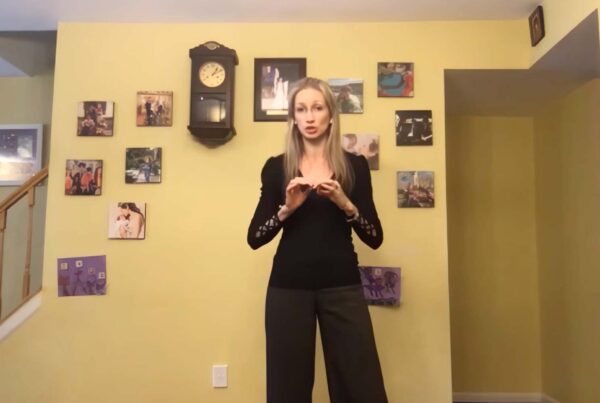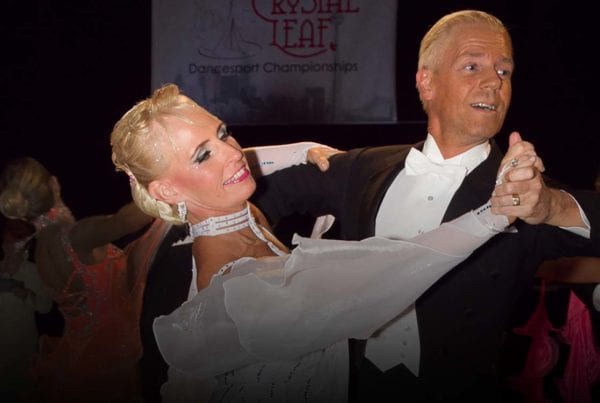The Hand to Hand is one of the most basic Latin steps, yet I’m always surprised how often it is danced poorly. Here is some information to help you improve your Hand to Hand in Rumba and Cha Cha.
While attending a competition some time ago, I observed that nearly every syllabus-level couple was dancing the Hand to Hand with seriously flawed technique. After watching more than a dozen couples making these same mistakes, I wondered if they were learning it wrong. But when the professionals competed, both in Pro/Am or in the Professional Division events, they all danced the Hand to Hand beautifully. I had to conclude that there were so many other things the coaches need to focus on that this detail was getting overlooked in their competitive students.
It’s time to give this basic step some attention.
In the Hand to Hand, the body turns to the left and right, away from the partner, in Right Side or Left Side position. The outside foot is placed back, while the other foot doesn’t move. The step is completed when the weight first replaces to the front foot and then the bodies return to the starting position with either a single step (Rumba) or Chasse (Cha Cha). It doesn’t matter which side you start, as this is based on the choreography. What does matter are the amount of turn and the foot and leg action.
Amount of Turn
The Hand to Hand turns one quarter in each direction. Variations such as Spiral Turns are allowed at higher levels but the Hand to Hand itself turns one quarter. The initial turn happens on step 1, while the return happens “over” steps 2 and 3. To achieve this, the weight must be over the ball of the foot, which is the normal weight position for Latin dances. This allows the standing foot to swivel on the ball while the moving foot passes through. Some dancers incorrectly allow the moving foot to “ronde” away from the body during the turn. It should pass through right next to the standing foot.
Weight Distribution
The most common problem that I see is incorrect use of pressure into the floor and timing of weight distribution. This is especially frequent in the Cha Cha, because of the speed of the step. Dancers attempt to create a “quick” action by placing their weight onto the back foot too rapidly, or their body weight placed over the heel. These errors cause the front foot to release from the floor. Far too often I even see ladies trying to create a kind of stylistic treatment of the front foot release by deliberately “flicking” the foot before replacing the weight.
In actual fact, there needs to be pressure into both feet at all times in Rumba and Cha Cha. Even steps that have no weight must maintain pressure into the floor. While the front foot can slide slightly before the weight is replaced, it must never release from the floor. The slide, if it happens, is the result of hip rotation as the back leg receives the rest of the body weight, and is never an intentional movement of the foot.
To achieve a beautiful Hand to Hand, the foot is first extended behind the body with the toe on the ground. The heel is then lowered as the weight is directed into the new standing leg and even more as it settles and the hip rotates during the completion of the weight transfer. If there is continued pressure into the front foot, both legs can be straight and therefore visually beautiful.
At the end of the hip rotation, the pressure from the back foot allows weight to transfer back to the front foot and contributes to the rotation back to the starting position.
Arms
Another common problem is incorrect use of the arms. There is a tendency, usually from the gentleman, to push the joined hands forward as the foot goes back. I believe this is a result of a misunderstanding caused by watching other dancers. While the weight transfer and hip rotation takes place, the joined hands may look like they are moving forward but they really are staying in place. It’s the hips rotating away that create an optical illusion of moving hands. You’ll look more stable and your movement clean and controlled if your hands don’t move.
Arms should extend out to the side, but should not be stretched behind the body. Again, this is a common mistake. As the hips rotate away from the partner at the completion of the weight transfer to the back foot, the body may also rotate slightly more. With the arm aligned to the side, it will appear to be slightly back but is actually just to the side of the body.
Timing
I believe that incorrect foot pressure is the biggest issue in this step and it is likely the result of trying to achieve a rapid “2” action. While it’s admirable that dancers are trying to create that musical accent, the way it should be done is by creating energy through your core and then releasing it between counts 1 and 2. This creates rotation and allows the leg to snap back in a very natural movement. Don’t place the weight onto the back heel too soon! It must be a sequence of ball, then heel as the weight transfer takes place. Far too often the heel is lowered too quickly, resulting in the previously mentioned release of the front foot from the floor.
Follow these steps to create a visually pleasing Rumba or Cha Cha.













